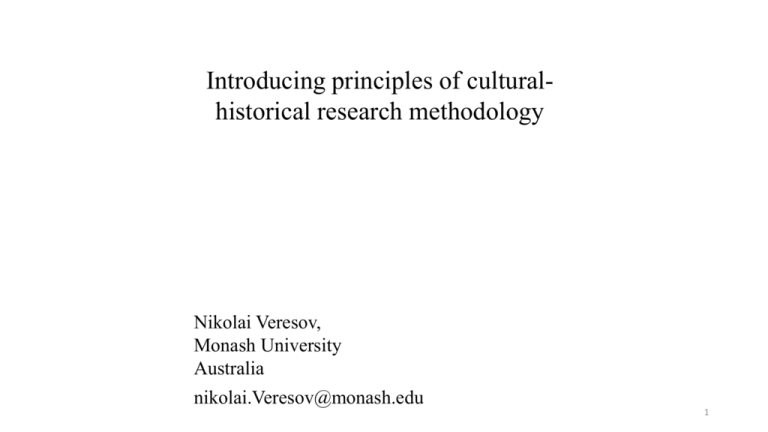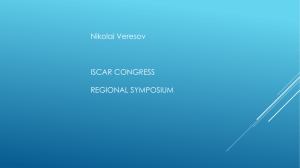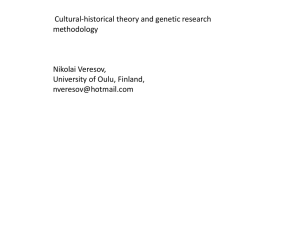S25_1600 Nikolai Veresov
advertisement

Introducing principles of culturalhistorical research methodology Nikolai Veresov, Monash University Australia nikolai.Veresov@monash.edu 1 EXPERIMENTAL-GENETICAL METHOD: The mental process itself, whether we speak of the development of speech or volition, is a process that undergoes certain changes before our eyes… The method we use may be called an experimental-genetic method in the sense that it artificially elicits and creates a genetic process of mental development. Due to this, we are able experimentally, in the laboratory, to elicit a certain development… (1997, Vol. 4, p. 68). Genetic = sociocultural genesis 2 3 4 GENETIC REASEARCH METHODOLOGY? What does it mean “to artificially elicit and create a genetic process of mental development”? What does it mean “to trace this development under certain conditions”? WE NEED TO IDENTIFY PRINCIPLES (requirements) OF GENETIC RESEARCH METHODOLOGY. Experimental conditions for development: • How to organise experimental settings? • How to conduct the process? • How to evaluate data obtained? 5 Veresov (2010; 2014): There are five basic principles of genetic research methodology (geneticexperimental method of study of the development of higher mental functions) • • • • • the principle of buds of development the principle of category/drama the principle of interaction of ideal and real forms the principle of developmental tools the principle of sustainable results Each of them is connected with theoretical concepts of cultural-historical theory and therefore is a research instrument for the experimental study of development 6 III. The Principle of Interaction of Ideal and Real Forms The social environment is the source for the appearance of all specific human properties of the personality gradually acquired by the child or the source of social development of the child which is concluded in the process of actual interaction of «ideal» and present forms. (Vygotsky 1998, p. 203) 7 We have a child who has only just begun to speak and he pronounces single words… The child speaks in one word phrases, but his mother talks to him in language which is already grammatically and syntactically formed and which has a large vocabulary, even though it is being toned down for the child’s benefit. Let us agree to call this developed form, which is supposed to make its appearance at the end of the child’s development, the final or ideal form ideal in the sense that it acts as a model for that which should be achieved at the end of the developmental period; and final in the sense that it represents what the child is supposed to attain at the end of his development. And let us call the child’s form of speech the primary … form. (Vygotsky 1994, p. 348) 8 There is no development if there is no interaction between the ideal and real forms. This principle means that in the course of experimental study: • both forms should be detected and presented • the higher “ideal form” must be present from the beginning of the experiment • tools and means of interaction between these forms should be specially created and involved in the experimental procedure OR: The researcher identifies ideal forms existing in child’s everyday life and looks at how they interact with children’s real forms and what are tolls which mediate these interactions. 9 Veresov, N., (2010). Forgotten methodology: Vygotsky's case. In J. Valsiner & a. Toomela (Eds.). Methodological thinking in psychology: 60 years gone astray? IAP, United States, pp. 267-295. Veresov, N., (2010). Introducing cultural historical theory: main concepts and principles of genetic research methodology. Cultural-Historical Psychology, 4, 83-90. Veresov, N. (2012). The importance of cultural-historical theory of education: Reflections on learning, development, business and creativity. Forum Oswiatowe, 1,46, University of Lower Silesia, Poland, pp. 141-156. Veresov, N., Bustamante Smolka, A.L., Paradise, R. (2013). Expanding the cultural-historical theory: fourth generation is coming? Cultural-Historical Psychology, 3, 51-54. Mackenzie, N. M, & Veresov, N. (2013). How drawing can support writing acquisition: Text construction in early writing from a Vygotskian perspective. Australian Journal of Early Childhood Education, 38,4, 22-29 Veresov, N. (2014). Refocusing the Lens on Development: Towards Genetic Research Methodology. In M. Fleer & A. Ridgway (Eds.). Visual Methodologies and Digital Tools for Researching with Young Children. Springer, pp. 129-149 Veresov, N. (2014).Method, methodology and methodological thinking. In M. Fleer & A. Ridgway (Eds.). Visual Methodologies and Digital Tools for Researching with Young Children. Springer, pp. 129-149 10 https://www.academia.edu/ 11 http://vimeo.com/ 12









